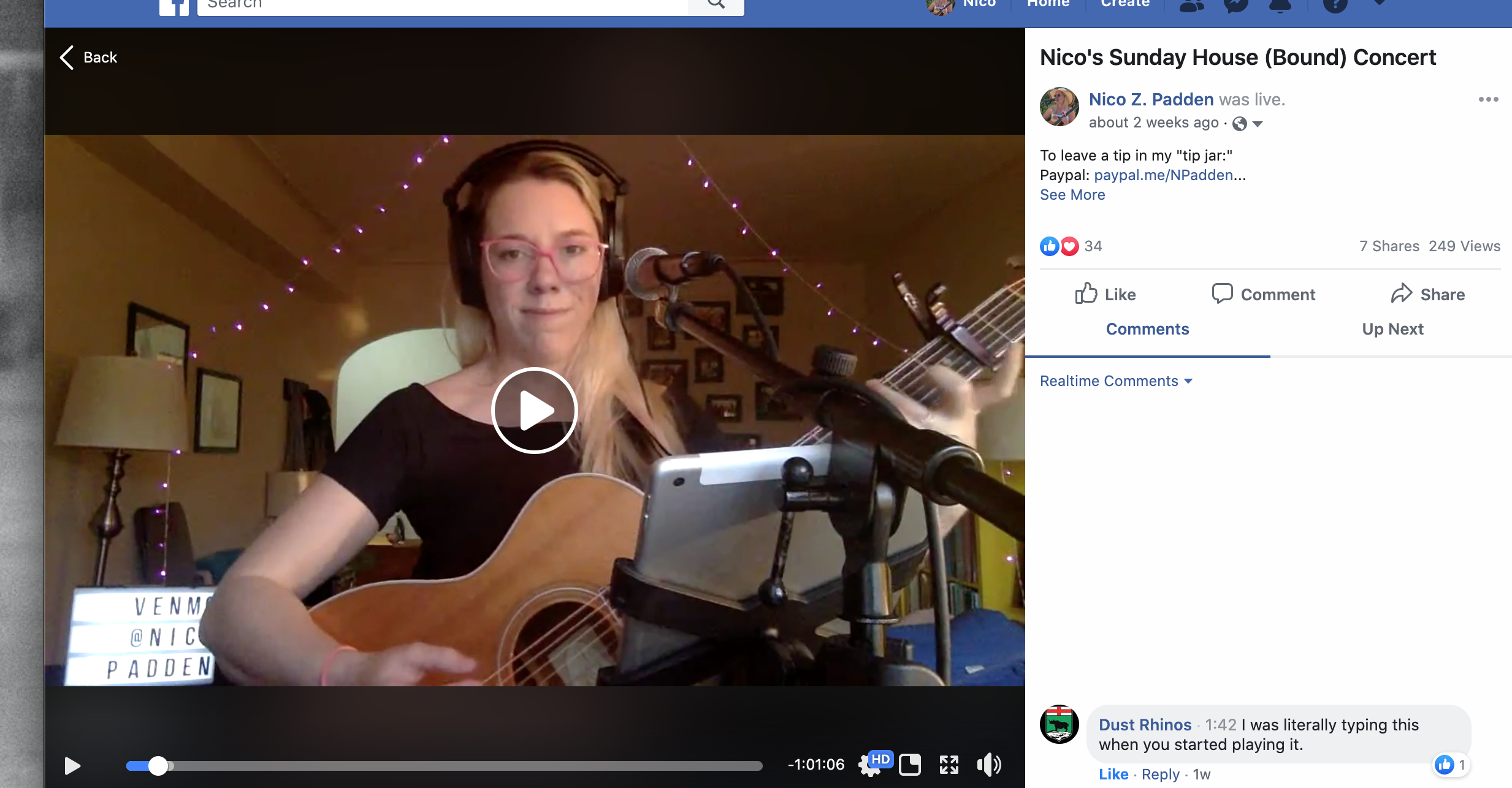Queens artists get creative to grow their audiences during pandemic
/Forest Hills folk singer/songwriter Nico Padden performs a live seat, remotely. Photos courtesy of Padden
By Emmy Freedman
On a Wednesday night in late March, Sarah Murdoch tuned her guitar and prepared to perform a live set.
Her heart thumping and her fingers positioned on the first chords, Murdoch faced her audience —a tiled grid of faces watching her perform on Facebook Live. Her roommate, dressed in a velvet dress befitting her front-row seat, watched her play from across the living room.
With just the click of a button, Queens musicians like Murdoch can transport themselves into homes around the world as the COVID-19 pandemic forces live shows online.
It might not be the preferred method of performing, but members of the Queens arts community intend to keep their craft alive while helping others escape the loneliness of quarantine.
“It’s this interesting thing of trying to continue to have a presence while also dealing with the overwhelm of the entire world being thrown upside down,” said Sarah Murdoch, a folk singer-songwriter based in Astoria.
As venues stay shuttered with no timeline for reopening, musicians like Murdoch have taken to video-communication systems like Zoom or Facebook Live to reach their audiences. That way, people can experience live music without having to jeopardize their health by leaving the house.
But going live from one’s home provides a new set of challenges.
Dancers work on their moves at Jean Franco Vergaray’s studio Salsa in Queens before the COVID-19 pandemic shut down venues. Photo courtesy of Vergaray
“It’s a little bit nerve-wracking the first time,” Murdoch said. “You’re playing, and you’re trying not to mess up, and you’re watching the comments and you’re trying to respond to them in between. It’s very different, and I think it’s unfortunately going to be the reality for the next year or two years until it’s safe to do live performances again.”
Nico Padden, a folk-rock musician in Forest Hills, has started performing online every Sunday night starting at 7:30 p.m. The shows are free, but audience members can chip in some money via a virtual tip jar. They can also make requests by scrolling through her song menu, which includes both covers and original pieces.
“Some people have lost their jobs, they can’t throw money in the tip jar,” Padden said. “But just by sharing to their friends, they’re helping me get exposed to a new group of possible fans. I mean, that’s extremely generous.”
Before COVID-19, Padden usually performed to audiences in the Tri-State area, but virtual shows — reaching people as far away as central Canada — have helped her grow her fanbase.
“I have a dear friend in Winnipeg, Canada, who would never get to see me gig unless I were to travel to Canada to do a house concert in his town,” Padden said. “He would never be able to see my weekly gig, and he and his wife have been tuning in almost every week. It’s really neat that so many possibilities have opened up.”
Jean Franco Vergaray, who teaches dance lessons and owns the Astoria studio Salsa in Queens, has noticed a similar trend of people around the globe logging into online salsa classes.
“We had a student who I believe I saw was in Mexico,” Vergaray said. “Not 100 percent sure how they found us, but I’m sure it was from word of mouth. That’s one thing my eyes opened up to is how far we can reach an audience beyond the Astoria community.”
Vergaray moved his salsa classes, which include “fam jam” classes for parents and children, online a few weeks ago. He said students are thankful that social distancing orders didn’t completely stop the dancing —people crave a way to let loose right now.
“[We’ve] been able to offer them a little bit of normalcy, a little bit of disconnect, to enjoy movement and let the body stretch — but not because of what’s happening, because of the exercise they’re doing, and how much fun it is to listen to music and engage with other people, and have instruction and have some form of instructor which right now it seems there isn’t much of outside of our home,” Vergaray said.
Vergaray is also planning a virtual date night event for June 20, which will allow him to combine his skills in both cooking and dancing. Vergaray will coach attendees on how to prepare a romantic dinner, and then provide a dance lesson while the food in the oven.
“We’ll break bread and sweat it off on our little dance floors at home,” Vergaray said.
Though virtual dance classes and online performances offer a fun alternative to isolated boredom, there’s no replacing the feeling of community inside a shared dance studio or cramped concert venue.
“Music is a thing that you don’t just hear with your ears, you feel the vibrations in the bones of your body,” Padden said.
“There’s a thing that happens when people are in the same room and I’m playing and they’re experiencing it — it’s a physical connection and you being able to experience that with people in the same room, there’s nothing like being in the physical presence of people when you’re playing for them,” she added.
Nevertheless, Padden said she’s willing to wait until the crisis subsides before she performs before in-person audiences again.
“I would much rather not get anyone sick,” Padden said. “I really feel like we just need to listen to the medical professionals and when they say it’s safe, then I’ll be happy to go back to playing gigs.”





